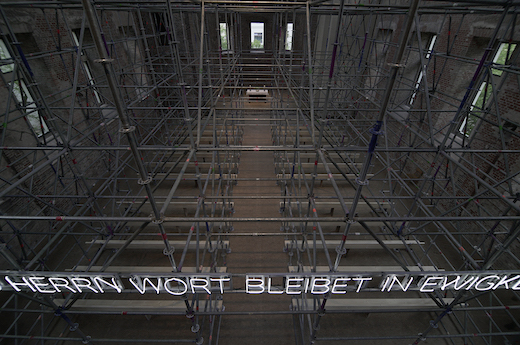Nested Churches - Installation von Riku Ikegaya
bis Montag, 1. Mai 2017 um tägl. 12-19 Uhr

Eine Stahlgerüstinstallation rekonstruiert wie eine Art dreidimensionale Architekturskizze die äußere Form der von Karl Friedrich Schinkel erbauten Kirche als offen begehbaren Pavillon mit Sitzbänken im Innern. Die physische Präsenz der Besucher durchmischt sich in ihrer Lebendigkeit mit der sakralen Ruhe der Kirche und entspannt so eine besondere Atmosphäre, die ein Kontinuum zwischen den Zeiten entstehen zu lassen scheint. „Die Kirche in der Kirche“ erinnert nicht nur an die ursprüngliche Funktion des sakralen Gebäudes als Versammlungsstätte und Ort der Andacht sondern auch an dessen Wandel im Verlauf seiner Geschichte von Zerstörung, Verfall und Wiederaufbau. Der provisorische Charakter der temporären Gerüstkonstruktion verweist auf das Unfertige, den Prozess von Werden und Vergehen. Somit letztlich auch auf die Vergänglichkeit unseres eigenen Daseins im Angesicht der Ewigkeit.
Alle Interessierten sind herzlich dazu eingeladen ihre Eindrücke der Ausstelllung und ihre persönliche Vorstellung von Ewigkeit in Wort und Bild mit anderen online (riku-ikegaya.com) zu teilen.
Vernissage: Mi 19. April um 18 - 21.45 Uhr
Öffnungszeiten: täglich 12-19 Uhr
Eintritt frei.
Kooperationspartner/Förderer: POLA ART FOUNDATION, artloft.berlin, Kultur Büro Elisabeth
Weitere Infos: www.riku-ikegaya.com.
Foto: Masaya KATO
English Version:
The installation Nested Churches by the Japanese architect and artist Riku Ikegaya is on display from April 19th through the end of Gallery Weekend. In this work he engages with the Genius Loci of the church and cultural center St. Elizabeth, which was designed by the famous architect Karl Friedrich Schinkel.
Ikegaya’s installation consists of a scale model of Schinkel’s architectural plans for the Rosentaler Vorstadt Church, which he transfers to the interior of the structure as a walk-in, three-dimensional architectural sketch. In the resulting pavilion, made of steel pipes generally used in scaffolding, the vital presence of the visitor combines with the sublime serenity of the church to create a unique atmosphere in which time seems suspended, allowing the visitor to contemplate the auratic memory of the space.
This „church in a church“ evokes not only the original function of the sacral building as a place of assembly and prayer, but also chronicles historical, cultural, and social change. The original building, heavily damaged in the Second World War, carries traces of the process of destruction, decay, and reconstruction. The temporary, provisional character of the pavilion implies „the unfinished“ and the cycle of coming into being and fading away. In this manner Ikegaya hints, perhaps, at the temporality of human existence as juxtaposed with concepts of eternity.
Press contact: Daniela Kickel, d.kickel![]() artloft.berlin
artloft.berlin
Foto: Masaya KATO





